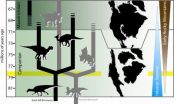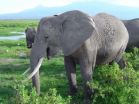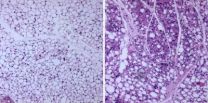(Press-News.org) To minimise the chance of being recognised and thus attacked by the birds they are trying to parasitize, female cuckoos have evolved different guises. The new research, funded by the Natural Environment Research Council, was published today, 03 August, in the journal Science.
The common cuckoo (Cuculus canorus) lays its eggs in the nests of other birds. On hatching, the young cuckoo ejects the host's eggs and chicks from the nest, so the hosts end up raising a cuckoo chick rather than a brood of their own. To fight back, reed warblers (a common host across Europe) have a first line of defence: they attack, or 'mob', the female cuckoo, which reduces the chance that their nest is parasitized.
Some female common cuckoos are grey and hawk-like, and previous research has shown that their resemblance to hawks reduces host bird attack. However, other females are bright rufous (brownish-red). The presence of alternate colour morphs in the same species is rare in birds, but frequent among the females of parasitic cuckoo species. The new research shows that this is another cuckoo trick: cuckoos combat reed warbler mobbing by coming in different guises.
Cuckoos are secretive. To widen their source of information about local cuckoo activity, reed warblers eavesdrop on the mobbing behaviour of their neighbours. In the study, the researchers manipulated local frequencies of the more common grey colour cuckoo and the less common (in the United Kingdom) rufous colour cuckoo by placing models of the birds at neighbouring nests. They then recorded how the experience of watching neighbours mob changed reed warbler responses back at their own nest.
They found that reed warblers increased their mobbing, but only to the cuckoo morph that their neighbours had mobbed. Therefore, as one cuckoo morph increases in frequency, local host populations will become alerted specifically to that morph. This means the alternate morph will be more likely to slip past host defences and lay undetected. This is the first time that 'social learning' has been documented in the evolution of mimicry as well as the evolution of different observable characteristics - such as colour - in the same species (called polymorphism).
Dr Rose Thorogood, of the University of Cambridge and co-author on the paper, said: "When mimetic disguises become less effective, evolving a polymorphism can be a successful trick. Our research shows that individuals assess disguises not only from personal experience, but also by observing others. However, because their learning is so specific, this social learning then selects for alternative cuckoo disguises and the arms race continues."
Professor Nick Davies, of the University of Cambridge and co-author on the paper, added: "It's well known that cuckoos have evolved various egg types which mimic those of their hosts in order to combat rejection. This research shows that cuckoos have also evolved alternate female morphs to sneak through the hosts' defences. This explains why many species which use mimicry, such as the cuckoo, evolve different guises."
###
For additional information please contact:
Genevieve Maul, Office of Communications, University of Cambridge
Tel: direct, +44 (0) 1223 765542, +44 (0) 1223 332300
Mob: +44 (0) 7774 017464
Email: Genevieve.maul@admin.cam.ac.uk
Notes to editors:
1. The paper 'Cuckoos combat socially transmitted defences of reed warbler hosts with a plumage polymorphism' will be published in the 03 August edition of Science.
2. The work was funded by the Natural Environment Research Council (NERC) is the UK's main agency for funding and managing world-class research, training and knowledge exchange in the environmental sciences. It coordinates some of the world's most exciting research projects, tackling major issues such as climate change, food security, environmental influences on human health, the genetic make-up of life on earth, and much more. NERC receives around £300 million a year from the government's science budget, which it uses to fund research and training in universities and its own research centres. www.nerc.ac.uk
Cuckoo tricks to beat the neighborhood watch
New research explains why female cuckoos have evolved different guises
2012-08-03
ELSE PRESS RELEASES FROM THIS DATE:
Breast cancer charity under fire for overstating the benefits of screening
2012-08-03
Professors Lisa Schwartz and Steven Woloshin of the Center for Medicine and the Media at The Dartmouth Institute for Health Policy and Clinical Practice argue that last year's breast cancer awareness month campaign by Susan G Komen for the Cure "overstates the benefit of mammography and ignores harms altogether."
Their views are published on bmj.com today as part of an occasional series highlighting the exaggerations, distortions, and selective reporting that make some news stories, advertising, and medical journal articles "not so."
A growing and increasingly accepted ...
5-year survey confirms Uruguay's world-leading tobacco control strategy is delivering results
2012-08-03
Implementation of graphic labels at 80% of the pack size front and back led to increased awareness of the risks of smoking
Ban on multiple brand presentations reduced smokers' false beliefs that some cigarettes (e.g., "light" or "mild" cigarettes) are less harmful
Strong support for tobacco control policies among smokers
(Thursday August 2nd, 2012, Montevideo, Uruguay and Waterloo, Ontario, Canada): The International Tobacco Control Policy Evaluation Project (the ITC Project) today launched a new report on the effectiveness of tobacco control policies in Uruguay. ...
Mountains, seaway triggered North American dinosaur surge
2012-08-03
ATHENS, Ohio (Aug. 2, 2012)—The rise of the Rocky Mountains and the appearance of a major seaway that divided North America may have boosted the evolution of new dinosaur species, according to a new Ohio University-led study.
The finding, published today in the journal PLOS ONE, may explain patterns of evolution and migration of North American duck-billed and horned dinosaurs in the years leading up to their extinction 65 million years ago, said Terry Gates, a postdoctoral researcher with Ohio University's Heritage College of Osteopathic Medicine who is lead author on ...
Close to the bone
2012-08-03
A genetic screening approach to studying bone disease has found nine new genes associated with bone health and suggests a new way to discover genes that may be implicated in human skeletal diseases. A collaborative study of the mineral content, strength and flexibility of bones has found clues to the cause of bone disorders such as osteoporosis, osteogenesis imperfecta, and high bone density syndromes. The study, which brings together specialist skills in mouse gene deletion and bone measurement to assess the strength of bones in 100 mutant mouse lines, is the largest ...
Modest weight loss can have lasting health benefits, research shows
2012-08-03
ORLANDO, Fla. – Overweight and obese individuals can achieve a decade's worth of important health benefits by losing just 20 pounds, even if they regain the weight later that decade, according to research presented at the American Psychological Association's 120th Annual Convention. With a focus on psychology's role in overcoming the national obesity epidemic, the session also examined research that indicates foods high in sugar and fat could have addictive properties.
Rena Wing, PhD, professor of psychiatry and human behavior at Brown University's Alpert Medical School ...
Study shows how elephants produce their deep 'voices'
2012-08-03
African elephants are known to be great communicators that converse with extremely low-pitched vocalizations, known as infrasounds, over a distance of miles. These infrasounds occupy a very low frequency range—fewer than 20 Hertz, or cycles, per second—that is generally below the threshold of human hearing.
Now, a new study shows that elephants rely on the same mechanism that produces speech in humans (and the vocalizations of many other mammals) to hit those extremely low notes. Christian Herbst from the University of Vienna, along with colleagues from Germany, Austria ...
NASA satellites see Tropical Storm Saola and Typhoon Damrey arm-in-arm near China
2012-08-03
Tropical Storm Saola and Typhoon Damrey appear on NASA satellite imagery to be arm-in-arm as they enter China on August 2.
NASA's Terra satellite passed over both tropical cyclones and captured them in one image, using the Moderate Resolution Imaging Spectroradiometer (MODIS) instrument onboard. MODIS captured a visible image on August 2, 2012 at 0245 UTC that showed the southern extent (or arm) of Typhoon Damrey, making landfall north of Shanghai, feeding into the northern extent (or arm) of Tropical Storm Saola, making landfall south of Shanghai. MODIS imagery also ...
Bacteria-immune system 'fight' can lead to chronic diseases, study suggests
2012-08-03
ATLANTA – Results from a study conducted at Georgia State University suggest that a "fight" between bacteria normally living in the intestines and the immune system, kicked off by another type of bacteria, may be linked to two types of chronic disease.
The study suggests that the "fight" continues after the instigator bacteria have been cleared by the body, according to Andrew Gewirtz, professor of biology at the GSU Center for Inflammation, Immunity and Infection. That fight can result in metabolic syndrome, an important factor in obesity, or inflammatory bowel disease ...
Research could lead to improved oil recovery, better environmental cleanup
2012-08-03
CORVALLIS, Ore. – Researchers have taken a new look at an old, but seldom-used technique developed by the petroleum industry to recover oil, and learned more about why it works, how it could be improved, and how it might be able to make a comeback not only in oil recovery but also environmental cleanup.
The technology, called "microbial enhanced oil recovery," was first developed decades ago, but oil drillers largely lost interest in it due to its cost, inconsistent results and a poor understanding of what was actually happening underground.
The new findings by engineers ...
New target for treating diabetes and obesity
2012-08-03
AUDIO:
Researchers at Washington University School of Medicine in St. Louis have identified a potential target for treating diabetes and obesity. They discovered that when a particular protein is disabled in...
Click here for more information.
Researchers at Washington University School of Medicine in St. Louis have identified a potential target for treating diabetes and obesity.
Studying mice, they found that when the target protein was disabled, the animals became more ...
LAST 30 PRESS RELEASES:
$80 million in donations propels UCI MIND toward world-class center focused on dementia
Illinois research uncovers harvest and nutrient strategies to boost bioenergy profits
How did Bronze Age plague spread? A sheep might solve the mystery
Mental health professionals urged to do their own evaluations of AI-based tools
Insufficient sleep associated with decreased life expectancy
Intellicule receives NIH grant to develop biomolecular modeling software
Mount Sinai study finds childhood leukemia aggressiveness depends on timing of genetic mutation
RSS Research Award for new lidar technology for cloud research
Novel AI technique able to distinguish between progressive brain tumours and radiation necrosis, York University study finds
Why are abstinent smokers more sensitive to pain?
Alexander Khalessi, MD, MBA, appointed Chief Innovation Officer
Optical chip pioneers physical-layer public-key encryption with partial coherence
How your brain understands language may be more like AI than we ever imagined
Missed signals: Virginia’s septic strategies overlook critical timing, study warns
Delayed toxicities after CAR T cell therapy for multiple myeloma are connected and potentially preventable
Scientists find cellular key to helping plants survive in saltwater
Medical cannabis program reduces opioid use
Immunotherapy works for sepsis thanks to smart patient selection
Cardiovascular events 1 year after RSV infection in adults
US medical prices and health insurance premiums, 1999-2024
Medical cannabis and opioid receipt among adults with chronic pain
Multichannel 3D-printed bioactive scaffold combined with siRNA delivery for spinal cord injury recovery
Triaptosis—an emerging paradigm in cancer therapeutics
A new paradigm in spectroscopic sensing: The revolutionary leap of SERS-optical waveguide integration and ai-enabled ultra-sensitive detection
Sweet tooth: How blood sugar migration in diabetes affects cavity development
Lowest suicide rate is in December but some in media still promote holiday-suicide myth
Record-breaking cosmic explosion challenges astronomers’ understanding of gamma-ray bursts
Excessive heat harms young children’s development, study suggests
Quanta Books to publish popular math and physics titles by Terence Tao and David Tong
Philanthropic partnerships fund next-generation instruments for mid-sized telescopes
[Press-News.org] Cuckoo tricks to beat the neighborhood watchNew research explains why female cuckoos have evolved different guises




